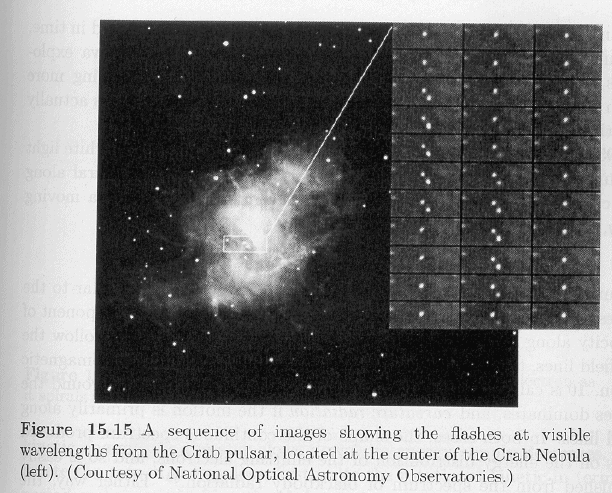
 Aliens?
Aliens?
 Aliens?
Aliens?Then another was found, and another. Not likely to be
aliens, these things were coined "pulsars".
What are they?
Orbiting neutron stars? No -- a binary neutron star would suffer orbital decay (GR), so that they would spiral inwards and their period would shorten.If pulsars come from neutron stars, and neutron stars come from supernovae, then we should find always pulsars in supernovae remnants, right?Pulsating stars? No -- Pulsation periods are too short for white dwarfs, too long for neutron stars (remember that, for oscillation, like grav collapse, P ~ 1/sqrt(rho) ).
Rotating stars? Ding! Rotation periods for collapsed neutron stars are just about the right period to explain pulsars.
Not really:

How would this make the nebula shine?
Synchroton radiation
Charged particles emit radiation when they are accelerated. Relativistic, accelerated charged particles will emit synchrotron emission, which has a spectral signature that depends on the particles energy and looks very different from a blackbody.So how could a pulsar be accelerating charged particles? Hint: Think about their strong magnetic fields...
The "shine" from the Crab comes from synchrotron radiation (L=5x1038 erg/s), but this energy has to come from somewhere (no free lunch!). Where does it come from?
The kinetic energy of a rotating object is given by
So the rate at which kinetic energy is changing is If we assume the Crab pulsar is a uniform sphere, then the moment of inertia is given by And putting in numbers for mass, size, period, and dP/dt, we get
In other words, the rate at which the Crab Pulsar is losing kinetic energy is almost exactly equal to the energy with which the nebula is shining.
Note that this is not the energy of the pulses -- they are much smaller in energy... Well, then, what about those darned pulses -- what are they?
 Pulsars
are rapidly rotating neutron stars with strong dipole magnetic fields.
But the magnetic field axis is not necessarily aligned with the rotation
axis (for example, on the Earth). As a result, the magentic poles will
"sweep through space" as the neutron star spins. If radiation from the
pulsar is entrained along the magnetic axis, a "lightouse effect" occurs.
Pulsars
are rapidly rotating neutron stars with strong dipole magnetic fields.
But the magnetic field axis is not necessarily aligned with the rotation
axis (for example, on the Earth). As a result, the magentic poles will
"sweep through space" as the neutron star spins. If radiation from the
pulsar is entrained along the magnetic axis, a "lightouse effect" occurs.
Question: How common are pulsars? We see ~ 600 or so. Are there more?
What causes this emission? It's not well understood, but along these lines:
Near the surface of the neutron star, the magnetic field is changing rapidly as the neutron star spins. A changing magnetic field induces a strong electric field. This electric field can be stronger than the force of gravity holding the charged particles onto the neutron star's crust. So charged particles are pulled off the surface and flung off into space, continually powering the synchroton radiation.The charged particles can emit radiation beamed along their direction of motion, making the coherent beam from the pulsar.